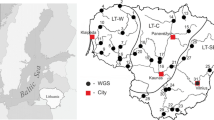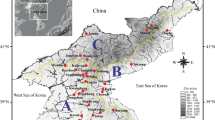Abstract
This paper reveals the nature of flood-season discharge and the associated impact on the upper and middle Yangtze river basin, on the basis of a historical database of daily discharges recorded at the Yichang (1865–1985) and Hankou (1878–1988) hydrological stations. Results show the period of discharge fluctuations of 2–6a, which is significant during 1878–1900 and 1915–1975 at Yichang station and the period of 2–7a during 1865–1905 and 1925–1975 at Hankou station. Within these periods, a major period of 2.9–3.5a and two secondary periods of 7–8a and 13.9–16.5a can be further identified from both stations. Our observation verifies that the fluctuations of streamflows of the upper and middle Yangtze River are fairly consistent with the periodicities of the Asia monsoon precipitation and ENSO event, reflecting coupling effect on the fluctuations of discharges in the Yangtze basin. In the 1920s–1960s, intensified variability of streamflows of the upper and middle Yangtze River was closely associated with warming temperature in the basin and in China as well. In 1975–1988, insignificant discharge fluctuations recorded at both stations can be chiefly attributed to human activities, i.e., the large number of reservoirs constructed and associated increasing capacity of water storage, which has largely weakened the discharge fluctuations throughout the basin.
Similar content being viewed by others
References
Changjiang Water Resources Commission (Ministry of Water Resources, China) (CWRC), (1865–1988). Hydrological Records of the Yangtze River. Beijing: Cyclopedia Press of China (in Chinese)
Ding Y H, Chan J C L (2005). The East Asian summer monsoon: an overview. Meteorology and Atmospheric Physics, 89: 117–142
Grinsted A, Moore J C, Jevrejeva S (2004). Application of the cross wavelet transform and wavelet coherence to geophysical time series. Nonlinear Processes in Geophysics, 11: 561–566
He L, Wu Y J, Dan C J, Xue H P (2007). Impacts of global temperature changes in last century on drought and flood disasters in Yangtze River Basin. Chinese Journal of Agrometeorology, 28(4): 364–366 (in Chinese)
Hu Z Z, Wu R G, Kinter J L, et al (2005). Connection of summer rainfall variations in South and East Asia: role of El Niño-southern oscillation. International Journal of Climatology, 25: 1279–1289
Jiang T, Zhang Q, Zhu D M, Wu Y J (2006). Yangtze floods and droughts (China) and teleconnections with ENSO activities (1470–2003). Quaternary International, 144(1): 29–37
Kondrashov D, Feliks Y, Ghil M (2005). Oscillatory modes of extended Nile River records (A.D. 622–1922). Geophysical Research Letters, 32: doi:10.1029/2004GL022156
Labat D (2008). Wavelet analysis of the annual discharge records of the world’s largest rivers. Advances in Water Resources, 31: 109–117
Labat D, Godderis Y, Probst J L, Guyot J L (2004). Evidence for global runoff increase related to climate warming. Advance in Water Resources, 27: 631–642
Lan Y C, Ma Q J, Kang E, Zhang J S, Zhang Z H (2002). Relationship between ENSO cycle and abundant or low runoff in the upper Yellow River (China). Journal of Desert Research, 22(3): 262–266 (in Chinese)
Li M T, Xu K Q, Watanabe M, Cheng Z Y (2007). Long-term variations in dissolved silicate, nitrogen, and phosphorus flux from the Yangtze River into the East China Sea and impacts on estuarine ecosystem. Estuarine, Coastal and Shelf Science, 71: 3–12
Long Z X, Li C Y (1999). GCM modeling of the impacts of the ENSO on East Asian Monsoon activities. Acta Meteorologica Sinica, 57(6): 663–671 (in Chinese)
Pavla P, Pavol M, Jan P (2003). Spatial and temporal runoff oscillation analysis of the main rivers of the world during the 19th–20th centuries. Journal of Hydrology, 274: 62–79
Tan A J, Chen X Y, Zheng Y X (1993). Yichang runoff time series statistical analysis. Hydrology, 5: 15–21 (in Chinese)
Torrence C, Compo G P (1998). A practical guide to wavelet analysis. Bulletin of American Meteorological Society, 79: 61–78
Wang B, Wu R, Fu X (2000). Pacific-East Asian teleconnection: How does ENSO affect East Asian Climate? Journal of Climate, 13: 1517–1536
Wang G J, Jiang T, Chen G Y (2006). Structure and long-term memory of discharge series in Yangtze River. Acta Geographica Sinica, 61(1): 48–56 (in Chinese)
Wang S W, Gong D Y, Zhu J H (2001). Twentieth-century climatic warming in China in the context of the Holocene. The Holocene, 1: 313–321
Wang W S, Ding J, Li Y Q (2002). Hydrology wavelet analysis. Beijing: Chemical Industry Press (in Chinese)
Xu J J, Yang D W, Lei Z D, Li C, Peng J (2006). Examination on long time variation tendency of precipitation and runoff in the Yangtze River basin. Yangtze River, 37(9): 63–67 (in Chinese)
Yang S L, Gao A, Hotz H M, Zhu J, Dai S B, Li M (2005). Trends in annual discharge from the Yangtze River to the sea (1865–2004). Hydrological Sciences-Journal-des Sciences Hydrologiques, 50(5): 825–836
Yin H F, Li C A (2001). Human impact on floods and flood disasters on the Yangtze River. Geomorphology, 41: 105–109
Yu J H, Ding Y G, Jiang Z H (2000). Singular spectrum analysis of temperature variations in China during the recent 100 years. Journal of Nanjing Institute of Meteorology, 23(4): 587–593 (in Chinese)
Zhang Q, Jiang T, Gemmer M, Becker S (2005a). Precipitation, temperature and discharge analysis from 1951 to 2002 in the Yangtze Catchments, China. Hydrological Sciences Journal, 50(1): 65–80
Zhang Q, Jiang T, Liu C L (2005b). Changing Trends ofWater Level and Runoff during Past 100 Years of the Yangtze River (China). Asian Water, Environment and Pollution, 3(1): 49–55
Zhang Q, Liu C L, Xu C Y, Jiang T (2006). Observed trends of annual maximum water level and streamflow during past 130 years in the Yangtze River basin, China. Journal of Hydrology, 324: 255–265
Zhang Q, Xu C Y, Jiang T, Wu Y J (2007). Possible influence of ENSO on annual maximum streamflow of the Yangtze River, China. Journal of Hydrology, 333: 265–274
Zhang Q, Xu C Y, Zhang Z X, Chen Y D, Liu C L, Lin H (2008). Spatial and temporal variability of precipitation maxima during 1960–2005 in the Yangtze River basin and possible association with large-scale circulation. Journal of Hydrology, 353: 215–227
Zhu Y F, Chen L X, Yu R C (2003). Analysis of the relationship between the China anomalous climate variation and ENSO cycle on the Quasifour year scale. Journal of Tropical Meteorology, 19(4): 345–356 (in Chinese)
Author information
Authors and Affiliations
Corresponding author
Rights and permissions
About this article
Cite this article
Dong, Y., Wang, Z., Chen, Z. et al. Centennial fluctuations of flood-season discharge of Upper and Middle Yangtze River Basin, China (1865–1988): cause and impact. Front. Earth Sci. China 3, 471–479 (2009). https://doi.org/10.1007/s11707-009-0064-y
Received:
Accepted:
Published:
Issue Date:
DOI: https://doi.org/10.1007/s11707-009-0064-y




